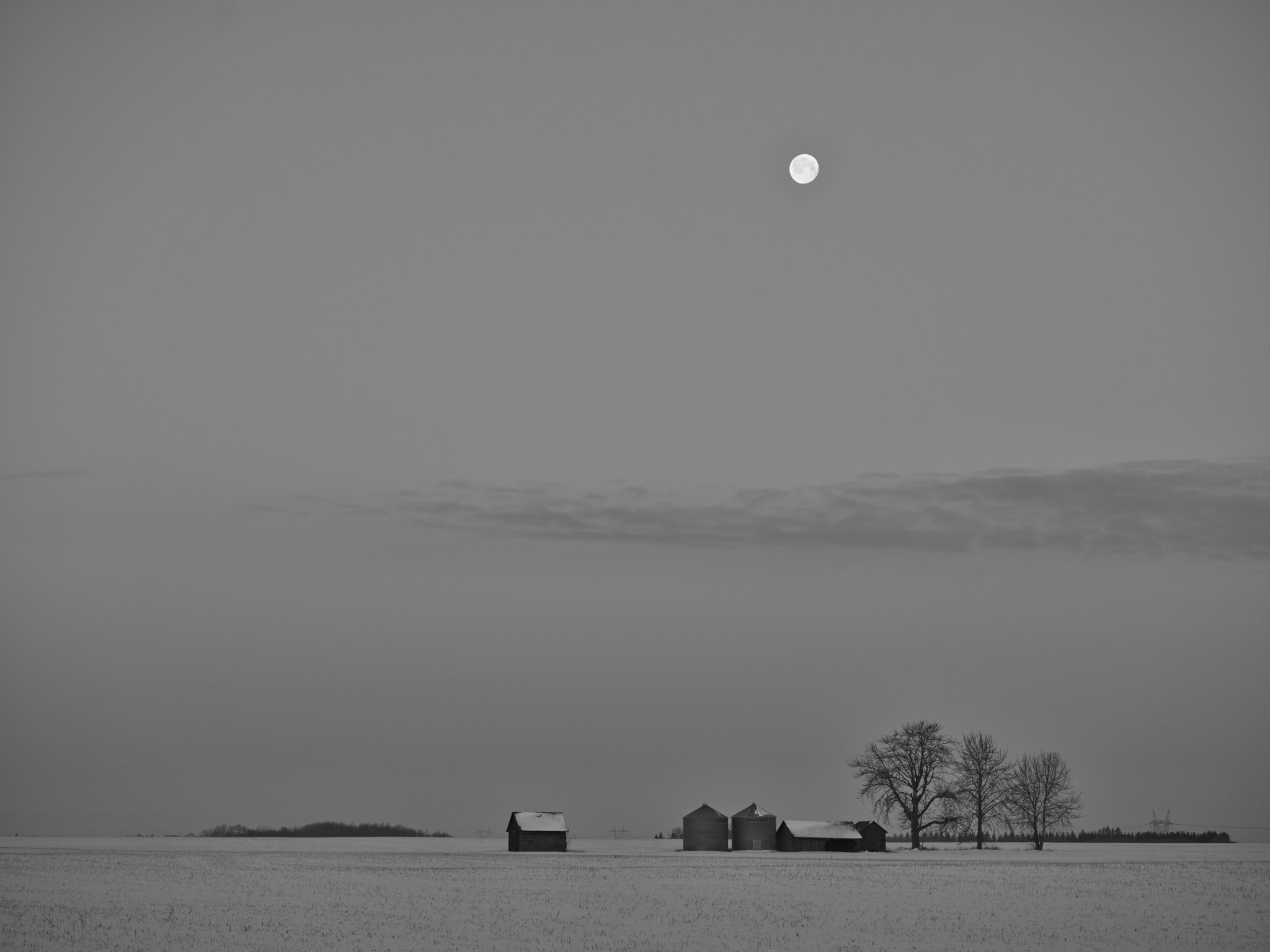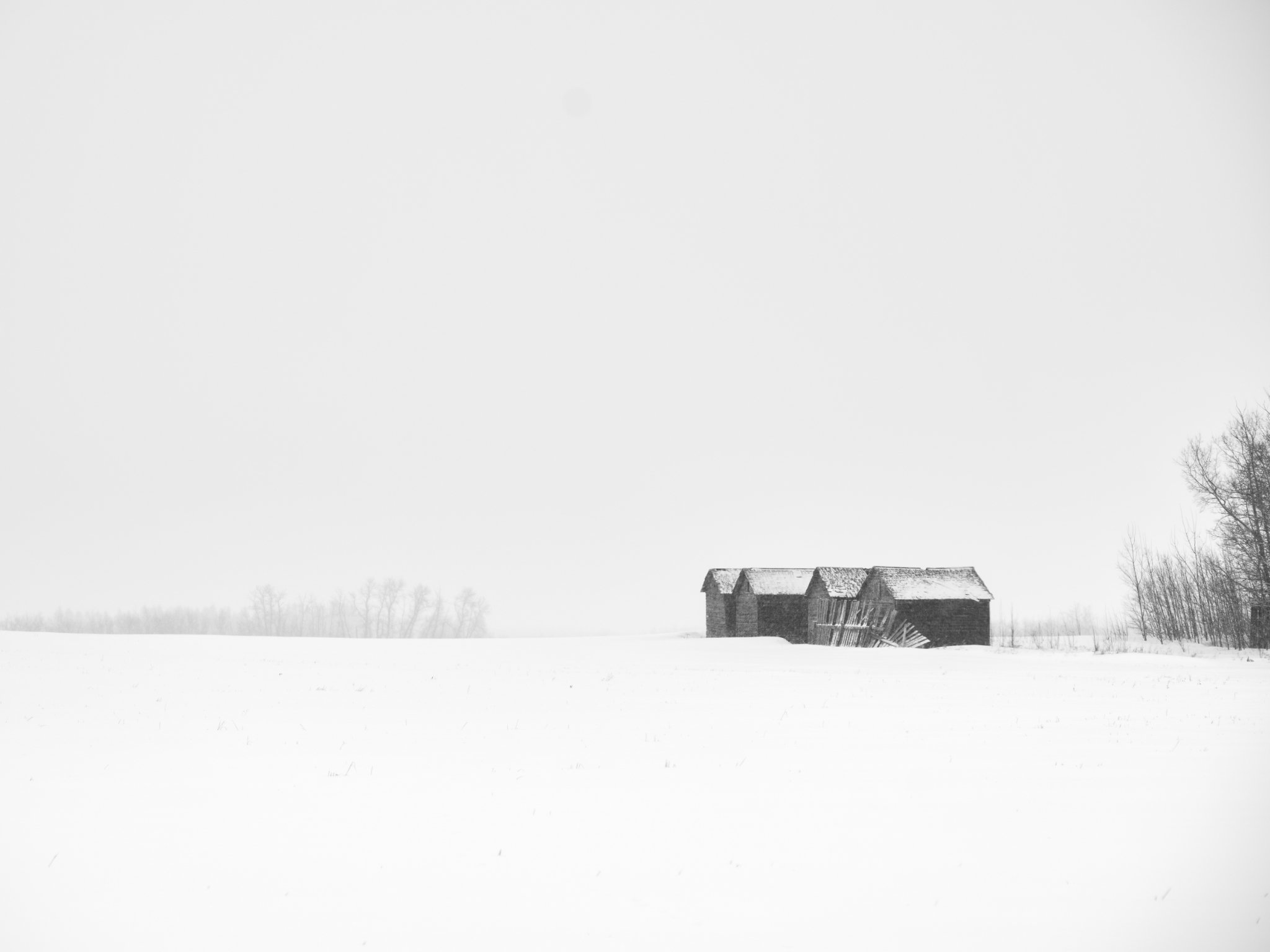Gear Review: Fujifilm Zoom Lens GF100-200mm F5.6 R LM OIS WR Lens
The Fujifilm GFX 100-200mmF5.6 R LM OIS WR is a telephoto zoom lens designed specifically for the Fujifilm GFX medium format camera system. With a versatile focal length range of 100-200mm, this lens offers a long reach that makes it well-suited for various photography genres, from portraiture and wildlife to sports and events. The lens also boasts a compact and lightweight design, making it highly portable and easy to handle.
I did not write a review on this lens despite owning it for many years since I did not find a proper application to use it — until now. Since January 2023, the Fujifilm GFX100-200mmF5.6 has been an essential lens for most of my landscape photography since I shifted my focus to photographing Albertan Prairies. You can read about it here, and I publish (almost) monthly updates on my progress. Now that I have used it for most of my winter photography, it’s time to write about it.
In this review, we will look closer at the features and performance of the Fujifilm GFX 100-200mmF5.6 lens to see how it stacks up against other telephoto zoom lenses on the market.
The Fujifilm GFX 100-200mmF5.6 is the fourth GF zoom lens, joining the wide-angle GF 20-35mm f/4 R WR, GF 32-64mm f/4 R LM WR, and the standard GF 45-100mm f/4 R LM OIS WR.
Build Quality
The Fujifilm GF 100-200mmF5.6 lens is a telephoto zoom lens designed for Fujifilm's medium format mirrorless camera system. It has a focal range of 79-158mm in 35mm format (for photographers coming from 35mm format), making it an ideal choice for portrait, landscape, and wildlife photography.
The build quality of the Fujifilm GF 100-200mmF5.6 lens is excellent. It is made of high-quality materials that feel durable and well-built. The lens barrel is made of metal, giving it a solid feel in hand. The focus and zoom rings are smooth and well-damped, allowing precise adjustments. The lens is also weather-sealed, making it resistant to dust, moisture, and extreme temperatures. This feature is handy for outdoor photographers who may encounter harsh weather conditions. One unique feature of the Fujifilm GF 100-200mmF5.6 lens is an internal focusing lens and does not change its length when you zoom, which is nice. It is a well-built, durable, and weather-sealed lens designed to withstand the rigors of professional use. The internal focusing design is a unique and helpful feature that differentiates it from other lenses in its class.
Full view of the Fujifilm GF 100-200mmF5.6 R LM OIS WR
Design Features:
The lens has several design features that help to improve its shock resistance. These include a built-in tripod collar that provides added stability and reduces the risk of the lens tipping over (However, I rarely use or have used a tripod collar). The lens also has a focus limiter switch, which allows you to limit the focus range, reducing the risk of the lens being damaged by accidentally extending beyond its limits.
One complaint is the Image Stabilization button, which I keep switching off accidentally when I use a glove. This does not happen on other lenses, such as the Fujifilm GF 45-100mmF4. Upon inspecting, I discovered a few things that make this happen:
The button is marginally less resistive compared with the Fujifilm GF 45-100mmF4, making it easy to flip
The positioning is slightly toward the center, right under my thumb (I guess it largely depends on the hand size)
Wearing a glove makes it worse, not providing that necessary tactile response
The OIS switch and the focus limiter where your left thumb goes when handholding this lens
The Fujifilm GF 100-200mm F5.6 lens is designed to be durable and withstand shocks and impacts. However, several factors can affect its shock resistance, including the construction materials, build quality, and design features.
Internal focusing
Internal focusing (IF) lenses have several advantages over traditional unit-focus lenses. Firstly, they can autofocus faster due to their lower mass. Additionally, their inner mechanisms help to keep the camera interior free of dust and humidity, which reduces the amount of debris that can accumulate on the sensor.
Furthermore, IF lenses can move their lens elements nonlinearly, allowing for better correction of certain types of aberrations across a broader range of focus distances. Lastly, the internal focusing lenses can eliminate focus breathing, which causes changes in magnification and angle of view when using traditional unit-focus lenses.
Image Quality
I am not a technical reviewer, so I avoid the MTF charts. However, I thought of giving a shot for this lens which has become my staple for the past four months.
A black and white photograph of a winter sunrise with rolling clouds obscuring a round sun, casting a soft glow across the edges. A line of trees appears as silhouettes against a hazy, gray background, and the snow-covered open fields reflect the soft light, creating a serene scene.
MTF Chart Analysis
The Fujifilm GF 100-200mmF5.6 lens MTF (Modulation Transfer Function) chart provides valuable information about the lens's ability to transfer contrast and sharpness from the subject to the camera's sensor. The MTF chart is a graph that plots the lens's contrast and resolution performance across the image frame, with separate lines for different distances from the center of the lens.
The MTF chart of the Fujifilm GF 100-200mmF5.6 lens shows that it performs well in sharpness and contrast, especially in the center of the image frame. The chart shows that the lens has high contrast and sharpness at the widest aperture of f/5.6, maintained through most of the focal range, up to about 150mm. However, the sharpness and contrast drop slightly towards the edges of the image frame, especially at the longer focal lengths.
At 200mm, the MTF chart shows that the sharpness and contrast at the edges of the frame are slightly lower than the center, which is expected with most lenses. However, the performance is still decent, with good contrast and detail throughout the image frame.
Optical performance
The Fujifilm GF 100-200mmF5.6 lens is impressive in terms of optical performance. The lens produces sharp, detailed images with good contrast, even when shooting wide open at f/5.6. The lens maintains excellent sharpness across the frame, with minimal distortion and vignetting. The lens also handles chromatic aberrations well, with little to no visible color fringing in high-contrast areas.
The lens has a minimum focusing distance of 0.6m, which is relatively close to a telephoto lens and allows for some creative close-up shots. The lens also features a 5-stop optical image stabilization system, which helps to compensate for camera shake and enables sharper handheld shooting in low light conditions. The autofocus performance of the Fujifilm GF 100-200mmF5.6 lens is fast and accurate (not so much for moving subjects), thanks to its linear motor system. The lens also has a relatively quiet autofocus operation, which is especially important when shooting video (which I do not shoot).
When aiming for starburst at the f/32, you have these artifacts close to the sunlight, which occurs more on the GFX-100s than the GFX-50s (of the mark II version of the same camera). It has less to do with the lens (maybe, to an extent, the lens does have its effect), but it is to do with the stacked sensor (warning: YouTube link).
Artifacts around the sunburst when at f/32 aperture
Lens Distortion, Chromatic aberration, and Vignetting
At the telephoto end of the zoom range (200mm), the lens exhibits some pincushion distortion, which can cause straight lines to appear curved in images. However, the amount of distortion is relatively minor and can be corrected easily in post-processing software.
The Fujifilm GF 100-200mmF5.6 lens generally has reasonable control over chromatic aberration, particularly at the wider end of the zoom range. However, chromatic aberration can be more noticeable at the longer end of the zoom range, particularly in high-contrast areas of an image. The Fujifilm GF 100-200mmF5.6 lens also features Fujifilm's "Super EBC" (Electron Beam Coating), which is designed to reduce lens flare and ghosting. While this coating is not explicitly intended to address chromatic aberration, it can positively affect overall image quality by reducing stray light entering the lens and interacting with the lens elements.
At its widest aperture of f/5.6, the lens exhibits noticeable vignetting when zoomed to its maximum focal length of 200mm. However, stopping down the aperture to f/8 or smaller largely eliminates this vignetting.
Overall, the level of vignetting is relatively typical for a zoom lens in this class and is not a significant issue. It may be visible in some images, especially those with high contrast, or in scenes with even lighting across the frame. However, it can also add a desirable effect to some photos, such as portrait shots with the subject centered in the frame.
Vignetting at the maximum focal length (f 5.6 - if you want to know the aperture)
Image Sharpness
At the 100mm focal length, the lens can produce sharp and detailed images across the frame. This is particularly true when the lens is used at its optimal aperture range of F5.6-F11. At wider apertures, such as F4 or F2.8, the sharpness may be slightly reduced towards the edges of the frame, but this is not unusual for lenses with wide apertures.
As the focal length is increased toward 200mm, the sharpness remains consistent across most of the frame. However, the corners of the frame may exhibit slightly reduced sharpness compared to the center of the frame. This is more noticeable when the lens is used at wider apertures, but it can be corrected by stopping down the lens to F8-F11.
Autofocus
Regarding autofocus performance, the GF 100-200mmF5.6 lens has a linear motor that provides fast and quiet autofocus making it well-suited for capturing slow-moving subjects like a deer (although I have a hard time nailing it). The lens also features an internal focusing system that helps minimize focus breathing (see the section discussing inner focusing for more information).
I failed to get sharp image of reasonably moving deer when zoomed out (200mm) despite the shutter speed and aperture (happens at f5.6 through f32)
Paired with the GFX-100s
When used with the GFX-100s camera, the GF 100-200mmF5.6 lens benefits from the camera's advanced autofocus system, which includes phase detection autofocus (PDAF) points that cover almost the entire frame allowing accurate and quick autofocus performance, even when tracking moving subjects. Furthermore, the GFX-100s camera offers advanced autofocus features such as face and eye detection, which can be particularly useful when shooting portraits. These features help to ensure that the subject's face and eyes are in sharp focus, even when shooting at wide apertures.
Paired with the GFX-50s
Without IBIS, the GFX-50s camera may struggle to maintain a stable image when shooting at longer focal lengths, particularly when the lens is zoomed to 200mm (also my experience with this lens and camera body combo). This can result in slower autofocus performance and potentially missed shots due to focus errors. However, the GF 100-200mmF5.6 lens has a relatively fast maximum aperture of f/5.6, which can help to offset some of the issues caused by the lack of IBIS. Additionally, the linear motor autofocus system of the lens should still provide relatively fast and accurate focusing, mainly when shooting at shorter focal lengths.
Paired with the GFX-50s Mark II
In the case of the GFX-50s Mark II camera, which features a contrast detection autofocus system, the autofocus performance of the GF 100-200mm F5.6 lens may not be that different from the original Fujifilm GFX-50s without the IBIS. This is because contrast detection autofocus relies on analyzing the contrast in the image to determine focus, which can be slower and less accurate than phase detection autofocus, which uses dedicated autofocus sensors to detect focus.
However, the GFX-50s Mark II camera does feature in-body image stabilization (IBIS), which can help to compensate for any camera shake that may occur during handheld shooting. This can help improve your images' sharpness, mainly when using slower shutter speeds or shooting in low-light conditions.
Applications (use)
Focal length range: The lens has a focal length range of 100-200mm, ideal for various photographic applications such as portrait, wildlife, and sports photography (well, you need lots of skills to photograph sports with this camera system in general).
Aperture range: The maximum aperture of the lens is F5.6, which may not be the widest available, but it is sufficient for most situations. It can also be stopped down to F32 for greater depth of field.
Image stabilization: The lens features optical image stabilization, which helps to minimize camera shake and produce sharper images when shooting handheld.
Autofocus: The lens features a fast and accurate autofocus system that can quickly lock onto subjects and track moving targets.
Weather-sealed construction: The lens is weather-sealed to protect against dust and moisture, making it suitable for use in challenging outdoor environments.
Using for portraiture
The Fujifilm GF 100-200mmF5.6 lens is designed for use with Fujifilm's medium format GFX system, providing a focal range of 100-200mm, which translates to approximately 79-158mm in full-frame equivalent. This makes it a suitable choice for portraiture, as it allows for a good amount of compression and bokeh, which can help to isolate the subject from the background.
One of the key strengths of this lens is its image quality. It has excellent sharpness, even when shooting wide open at f/5.6, and produces little distortion or chromatic aberration. The lens also has a nice smooth bokeh, which can help to make the subject pop and create a sense of depth in the image.
Regarding handling, the GF 100-200mmF5.6 is a relatively compact and lightweight lens, weighing just under 2 pounds — making it easy to carry around and use for extended periods without causing undue fatigue (I have taken it for two hikes, and I know its true for me). The lens also features a weather-sealed construction, which helps to protect it from dust and moisture, making it suitable for use in various outdoor environments.
Landscape photography
One of the main benefits of using a telephoto lens for landscape photography is that it isolates specific scene elements and creates a compressed perspective making it useful when you emphasize the size and scale of distant mountains or other features in a landscape. This lens's 100-200mm focal length range is well-suited for this purpose, and the maximum aperture of F5.6 provides a good balance of depth of field and light-gathering ability.
However, there are some limitations to using a telephoto lens for landscape photography. One challenge is capturing wide vistas or large areas of a landscape, except by stitching together multiple images. Telephoto lenses are also heavier and bulkier than wide-angle lenses, making them less convenient to carry and use in the field.
Conclusion
In conclusion, the Fujifilm GF 100-200mm F5.6 R LM OIS WR lens is an excellent telephoto zoom lens with exceptional image quality and versatility. With its compact and lightweight design, weather-resistant construction, and advanced optical technologies, this lens is a great option for photographers who demand the best performance and portability.
The lens's internal focusing design makes it easy to carry and store without worrying about returning the lens to its original state when storing, while its high-quality materials ensure durability and long-lasting performance. The inclusion of advanced technologies such as Linear Motor and Optical Image Stabilization makes it easier to capture sharp, clear images even in challenging lighting and shooting conditions.
Overall, the Fujifilm GF 100-200mm F5.6 R LM OIS WR lens is a highly recommended option for Fujifilm GFX medium format camera users looking for a high-performance telephoto zoom lens that delivers exceptional image quality and versatility. Its lightweight and weather-resistant design, advanced technologies, and excellent image quality make it a standout option in the telephoto zoom lens category.



















